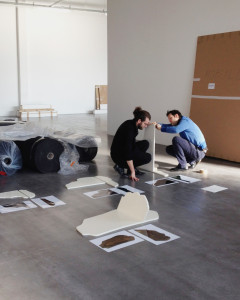Anne Holtrop’s hand-painted furniture mines the magic of mimicry.
The Secrets of Stones
-
Anne Holtrop and Kwinten Lavigne at work in WIELS Contemporary Art Centre
<i>Courtesy of Maniera</i>
-
At work in WIELS Contemporary Art Centre
<i>Courtesy of Maniera</i>
-
At work in WIELS Contemporary Art Centre
<i>Courtesy of Maniera</i>
-
At work in WIELS Contemporary Art Centre
<i>Courtesy of Maniera</i>
-
At work in WIELS Contemporary Art Centre
<i>Courtesy of Maniera</i>
-
Workshop of Sylvie Van Der Kelen
<i>Courtesy of Maniera</i>
-
Workshop of Sylvie Van Der Kelen
<i>Courtesy of Maniera</i>
-
Exhibition view, Hanging Desk by Anne Holtrop
<i>Courtesy of Maniera; Photo © Sven Laurent</i>
-
Exhibition view, Hanging Desk by Anne Holtrop
<i>Courtesy of Maniera; Photo © Sven Laurent</i>
-
Detail of Hanging Desk by Anne Holtrop
<i>Courtesy of Maniera; Photo © Sven Laurent</i>
-
Exhibition view, Shelves by Anne Holtrop
<i>Courtesy of Maniera; Photo © Sven Laurent</i>
-
Shelve 1 by Anne Holtrop
<i>Courtesy of Maniera; Photo © Sven Laurent</i>
-
Exhibition view, Shelve 3 by Anne Holtrop
<i>Courtesy of Maniera; Photo © Sven Laurent</i>
-
Exhibition view, Mirror Room Divider by Anne Holtrop & Solo Chairs by Kersten Geers David Van Severen
<i>Courtesy of Maniera; Photo © Sven Laurent</i>
-
Exhibition view, Hanging Desk by Anne Holtrop
<i>Courtesy of Maniera; Photo © Sven Laurent</i>
-
Trompe l'oeil studies for storefronts and vestibules. Geslin, 1838. From "Decorative Painting The Van Der Kelen Way," by Denise Van der Kelen, 2010.
<i>© Institut Supérieur de Peinture Van der Kelen-Logelain</i>
-
Marble class at the Institut Supérieur de Peinture Van der Kelen-Logelain. From "Decorative Painting The Van Der Kelen Way," by Denise Van der Kelen, 2010.
<i>Photo © Institut Supérieur de Peinture Van der Kelen-Logelain</i>
-
Plates illustrating Van der Burg's book "Manuel de peinture pour l'imitation des bois et des marbres." From "Decorative Painting The Van Der Kelen Way," by Denise Van der Kelen, 2010.
<i>© Institut Supérieur de Peinture Van der Kelen-Logelain</i>
Anne Holtrop is an architect by trade, but his Amsterdam-based practice has an eccentric fluidity that renders such labels almost superfluous. Yes, he conceives buildings in the traditional sense—like the in-progress Museum Fort Vechten in Utrecht and the National Pavilion of the Kingdom of Bahrain. But many of Holtrop’s projects equally engage the principles of fine art, design, and more. With a recent series for Belgian limited-edition editors Maniera, Holtrop has branched out into furniture, creating unique and intricate shelves, a desk, and a mirrored room divider that manipulate artificial materials (MDF and paint) to conjure the natural world—namely, the patterns and textures of a particular collection of stones owned by 20th-century philosopher-sociologist, Roger Caillois.
Caillois (1913–78) ran in vanguard intellectual circles in the middle part of the last century. Most famously, he was a friend of Surrealist André Breton until they had a disagreement over a Mexican jumping bean. Caillois speculated that a worm was responsible for the legume’s life-like movements and wanted to cut it open for proof. Breton, meanwhile, preferred to remain ignorant of the mechanics behind what he saw as an enchanting, magical phenomenon. Caillois’s inclination toward empiricism was not, as one might think, aimed at purging the world of its magic. Rather he believed that contemplating the mundane, exposing the natural order, was directly linked to the experience of awe. (For more on this fascinating subject, see Marina Warner's excellent 2008 article for Cabinet Magazine.)
“I came across a book that Caillois wrote about his collection of agates, jasper, and onyxes, called The Writing Of Stones,” Holtrop explains. “For him—and also for me—stone isn’t just lifeless material; it depicts images. He called them messages in the stones, the secret cyphers of the universe that, like a Rorschach inkblot, trigger the imagination. It’s at once science and flight of fancy.”
In order to capture the aesthetics of Callois’s rocks, Holtrop commissioned hyperrealist Belgian artist Sylvie Van der Kelen of the Institut supérieur de peinture to paint the surfaces of the furniture with a trompe l’oeil effect. Van der Kelen, the granddaughter of the founder of the Brussels-based technical school, focused on the naturalistic replication of marble and wood grains. Her involvement “added an extra layer to the already multi-layered aspect of the stones—an interpretation of the material,” Holtrop notes. “From a distance they look exactly like stones. And when you get close up, you see the brush strokes—you see it is an extraordinary painting. It brings an ambiguity, where more than one viewpoint is possible.”
That ambiguity is central to Holtrop’s larger practice, whether he’s creating free-form Rorschach-style ink drawings (as he did recently during a sojourn to Korea) or combining materials in unexpected and perhaps provocative ways (as in his Batara project, which found him working with sand, foam, and concrete). For Maniera, it was also important that Holtrop himself exercised control over the final form and selection of the pieces, combining various painted segments in unexpected, spatially engaging ways. “The shelves are collages of the material we had on our table while working—they’re all made of fragments, or off-cut pieces,” he says. “But I wanted them to be ‘space spaces,’ little environments.” Holtrop envisions a scenario in which the Caillois-inspired Maniera pieces could constitute a totally unified, immersive interior: a lush and decorative architecture. Even on their own, these works are more than room décor. “They become less utilitarian and more like little milieus in which to place things,” Holtrop says. “The possibilities are endless." As Caillois said, stones are l'orée du songe, the shore of dreaming.
Maniera will present Holtrop’s rocky series at the 24th Biennale Interieur in Kortrijk City, Belgium, from October 17 through 26.
-
Text by
-
Scott Indrisek
Scott is the executive editor of Modern Painters and the founder of Brant Watch. He lives in Bedford-Stuyvesant, Brooklyn, with two erudite cats.
-



















 At work in WIELS Contemporary Art Centre
Photo courtesy of Maniera
At work in WIELS Contemporary Art Centre
Photo courtesy of Maniera
